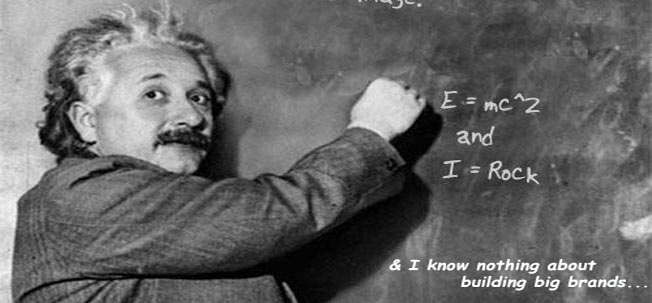The conventional wisdom in the business world is that if you want to be an entrepreneur, then you need to get an MBA. The MBA will teach you the principles behind running both young and mature companies, how to avoid mistakes and even the theory needed to build a profitable brand.
What’s interesting is that a lot of that advice can be turned on its head or even ignored. I’m not knocking MBAs—I know they offer a lot of value. But while theory is good, old fashioned practice (learning by doing) really is the best method, and the real world marketplace is the best classroom.
So, what I want to offer you today are the lessons that I and other successful business owners and managers have learned through the school of hard knocks. These are lessons that will help you create a world-renowned brand that attracts leads, dominates competition and rakes in the cash.
Let’s take a look at ten branding lessons that you won’t learn in graduate school.
Lesson #1: Being smart isn’t enough to create a big brand
You also have to be a leader. That was the lesson that Drew Houston, founder of DropBox, discovered while still in college. He enjoyed his business when it was just him and his code. But then he came across a book that changed his perspective.
The book was Daniel Goleman’s Emotional Intelligence. After reading it, he was convinced that if he wanted to build a big company with a big brand, then he needed more than intelligence and a degree.
That’s when he started to read books on business, leadership and management. He immediately put that knowledge to work by leading two organizations at college. That experience turned out to be a crash course in getting things done through other people.
Takeaway: Buy or borrow as many books as you can on leadership, management and salesmanship. Hook up with business mentors who are where you want to be. Even take some classes on management and leadership. And then hustle harder than everyone else.
Lesson #2: Build a cult…not a company
Apple is easily one of the most recognized brands in the world. And it has one of the most loyal fan bases, too. Why? Because Apple created a brand that is way more popular than any single product they create.
See, it doesn’t matter if it is a Mac, iPhone or iPad. What matters is that it is an Apple.
Compare this to Research in Motion (RIM), the maker of the Blackberry. Their smart phone is vastly cooler and more popular than the company. In fact, ask people if they’ve ever heard of RIM, and most will give you a blank stare.
In fact, search Blackberry and RIM on Google Insights, and the volume for the product will be higher than for the company. Do the same thing with Apple and iPhone, and you’ll see that the spikes are always side by side, meaning people talk about the company as much as they talk about their products.
Takeaway: Create products and experiences that are based upon your brand and core message in order to cultivate that almost cult-like connection with your customers. Focus on building the killer brand, not the killer product.
Lesson #3: Start with why
Speaking of building the killer product—this is how many companies begin their branding journey. They look to create the product that changes lives and neglect the brand.
Let’s look at Apple again. They will never start with the common what-how-why advertising message. Instead, they flip that formula so it is why-how-what. They start off by promoting the reason why they exist. It’s as if they say something like this: “Apple exists to challenge the status quo. We emphasize gorgeous design. And we happen to make digital devices.”
The reverse of that is this: “Apple makes digital devices. They are gorgeously designed. We exist to challenge the status quo.” See how that can make a difference. The first emphasizes the mission, while the other emphasizes the product. Products come and go. A brand should last forever.
Takeaway: Get everyone involved in understanding the mission—the why you exist. This starts at the top and works all the way down to the bottom. Then everyone is working to create a meaningful way to get people to see your brand, not just your products.
Lesson #4: Burn your business plan
Attend any graduate school or course on being an entrepreneur, and you will eventually hear your instructor tell you that a smart entrepreneur needs a business plan.
The business plan is supposed to lead you and guide you. But you don’t always need it.
The founders behind Proof Wood, a maker of sustainable wood sunglasses, were told to write a business plan—but didn’t. Instead, they just ran with their idea.
As Inc reported, CEO Brooks Dame said “After the company launched, we finally wrote one for a business plan competition, in order to raise money. But the truth is, we’ve deviated from it so much, we never even refer to it.”
Dame goes on to say that a business plan can make you over think your product. So you spend endless nights re-tooling it to get it perfect. But once you get it to market, you may be too late.
Takeaway: When it is a race to the market, you may have to rely on nothing more than your idea—and then just run with it. Keep an eye on the competition. You can always create a business plan later on.
Lesson #5 Create your own market
It’s an uphill battle if you try to enter a market that is over-crowded. The same is true for a market that is shrinking. The only way to guarantee your success is to create a new market.
That is what Amazon did with the e-reader back when it was nothing more than a fuzzy concept. They gave the early adopters something they could play with while the rest of us caught up.
Amazon was criticized for taking such a risky move; but since they got to define that new market, they now own it and their critics are silent.
Of course Kindle Fire isn’t as great as Amazon had hoped, and Amazon is plagued by problems from publishers and libraries over privacy and pricing guidelines, but they still dominate.
Takeaway: Try to peer past the horizon and look for markets that are undervalued. Do they have promising growth? Launch a concept video to test the waters. Then quickly get to work.
Lesson #6: Rebrand to avoid confusion
Multiple product lines can cause headaches for a brand—especially when the brand name and the product name aren’t aligned.
This happened to Formspring when they started to attract a different fan base with a social media product. The problem is that they are known for a business-related, form-building product.
The company was causing confusion between the two products, so they decided to re-brand themselves. The task wouldn’t be easy because they had a lot of authority built up in their original brand.
They solved the problem by creating the perfect landing page infographic to educate their customers. On StumbleUpon alone, the infographic was shared over 100,000 times, bringing exposure to their new brand quickly.
Takeaway: Start from the top down. Start with the why. The brand. Then build products underneath that. Formspring is a classic example of a company that started with a product and not a brand. They also are a great example of how to overcome that hurdle. So, don’t be afraid to re-brand, especially if it will end brand confusion.
Lesson #7: Your customers aren’t who you think they are
Most companies are started by people who build products for like-minded friends and family. When they start a business, they think they know who their target market is.
That was certainly the case for Proof Wood founders who were creating their wood sunglasses for skateboarders and surfers. But a trip to a conference proved they were wrong.
Not only were the environmentally conscious interested in the sunglasses, but so were hip hop artists and housewives. The company realized the sunglasses had a mass appeal, and they eventually landed in 120 stores, including Nordstroms. The company sells over 1,800 pairs of sunglasses a month.
This has happened to a lot of companies like Vans, and even hip hop music itself.
Takeaway: Be adaptable. Try not to get locked into thinking you know who your customer is. Release your product and watch where it goes. Look for opportunities to exploit.
Lesson #8: Get edgy
There is a reason that Jim Beam, the 216-year-old whiskey company, is still around. It goes after profitable markets, even if it doesn’t make sense.
They started by looking at markets ignored by their competitors. The most obvious one in the big spirits business is women. Even though women made up half of vodka consumers, no big spirits company focused on them specifically. In fact, the general strategy was to get the men in, and then the women would follow.
Jim Beam jumped on the opportunity and created products exclusively for women, like a margarita variety called Bethenny Frankel’s Skinnygirl Cocktails — which is a number one selling brand.
Takeaway: Can you find a lucrative market that your competitors are ignoring? What do they want? Can you give it to them? In Jim Beam’s case, women wanted flavor and lower-alcohol big spirits. And can you re-shape your brand to look edgy and relevant? It may be worth it.
Lesson #9: Attention to detail in the small stuff
Sometimes the best ideas are simple. Take the idea that founders, Richard Tait and Whit Alexander of the board game Cranium, used to get everyone on the same page about the brand.
What they decided to do was create a playful acronym: CHIFF. That meant clever, high quality, innovative, friendly and fun. This acronym became ingrained into the minds of every employee at Cranium.
It had such an effect on the brand that one marketing manager pulled a French Canadian packaging design that used the phrase “splendid talents” on the box and replaced it with “mind boggling.” The fear was that the wrong phrase on the box design might not register with potential customers. That’s a pretty intense level of attention to detail, but it has made the company a huge brand success, and it all started on a very simple idea.
Takeaway: When you sweat the small stuff, a lot of times it will take care of the big stuff. Create easy ways to get everyone on the same page about your brand. Then discipline yourself to pay attention to the detail of everything.
Lesson #10: Burn your ships
When you start a company, you may start off with one set of customers. Over time, you may realize that they are not the customers you want in the long run.
So you cut them off.
That’s exactly what Stormpulse, a storm tracking and alert service, did after five years of being in business. Founder Matt Wensing noticed that some of the consumer accounts that he had were owned by people who worked at the White House and FedEx. At that point, he realized he needed to focus on big business if he wanted to create a long-term brand.
The consumer accounts were paying him only $50 a year, and Wensing figured he could make 10 times that with the enterprise customers. It was a gutsy move, but it’s since paid off.
They now have 200 enterprise customers and hope to secure additional funding. Then they will be able to hire more people to improve UX and field all the sales leads they are getting.
Takeaway: Don’t be afraid to piss some people off—as long as you can make some other people really happy, and the move is lucrative.
Conclusion
Now, one of the greatest branding lessons that I have learned from the above experiences and my own is that you’ll never be able to build a great brand based on a formula. It just doesn’t work that way.
What works is creativity, hard work and the willingness to make mistakes—lots of them. The school of hard knocks will teach you some great lessons on building a brand that you’ll never get from an MBA.
So, get your MBA, but also get your experience.
What branding lessons have you learned (that you didn’t learn in school)?









Comments (18)